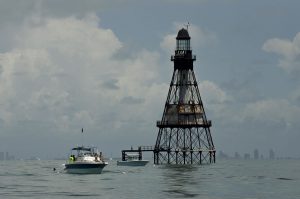
Here in Florida, we are fortunate to have conditions that allow for boating activity year round. Throughout the state, in other parts of the US and even around the world, boaters pass white buoys floating on the surface of the water. During my period of employment and subsequent volunteer tenure with Biscayne National Park, I often encountered boaters who were confused as to what those balls were, and as a result, simply avoided them. Ironically, mooring buoys (see photo 1) are employed to be used by the very boaters that are avoiding them.
Mooring buoys mark sites for boat access to fishing, snorkeling, and SCUBA diving activities. The buoy at the surface is attached to the bottom by a line that is connected to a permanent anchor. The benefits of this system are two-fold: boaters can enjoy an area without having to anchor their vessel, and the buoy provides access to sensitive cultural and/or natural resources. This is of particular importance, per Florida’s Coral Reef Protection Act, anchoring on coral reef or hardbottom areas is illegal. Anchor damage to corals can result in injury or death of the organism, depending on the severity and species type.
Buoys are intended for use on a first-come, first-served basis and are intended to promote use of an area and visitation. In Florida, mooring buoys are white with a blue stripe around the center of the buoy. In other countries, this might differ. When boating, be sure to consult local navigational charts to reference specially zoned or marked areas, which may contain buoys that are different colors.
To use a mooring buoy:
- Approach the buoy against the wind or current, whichever is most effecting your boat’s course.
- Use a boat hook to pick up the mooring line. Run a line from your boat through the mooring line to allow for plenty of scope, or length of line that you attach from your boat to the buoy. Never tie your boat directly to the mooring line.
- Make sure you allow for enough scope so that the buoy is not being pulled under the surface. Sufficient scope is especially critical during rough or windy conditions.
- Once your lines are tied, inspect the lines and buoy to make certain that the system is secure.
- Bear in mind that buoys are installed in popular recreational areas, so approach at idle speed and be on the lookout for swimmers and divers.
Here are links for mooring buoys in Southeast Florida, from south to north:
Florida Keys National Marine Sanctuary
Happy and safe boating!
 0
0
